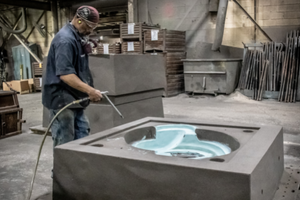Anatomy of a Pour: Sand Casting Photo Story
Sand casting is a versatile and cost-effective technology that has been used for thousands of years. Nearly any part configuration can be created in metal as a sand casting. Stainless Foundry & Engineering (SF&E) has specialized in sand casting since we opened our doors in 1946. We’ve documented our process in a series of photos below as a way to pay homage to this time-honored practice.
What is Sand Casting?
The metal components required for industrial use today need to be able to withstand various environments. The type of environment can range from a physical location such as underwater or in the atmosphere, to the conditions of the environment, such as equipment that continuously runs or moves caustic materials. High-quality castings and high-performance alloys are especially critical in the industries SF&E serves, including aerospace, marine, power generation, chemical, pulp and paper, food and dairy, nuclear, pharmaceutical, and military/Department of Defense.
Castings are made by pouring molten metal into pre-formed molds. Sand castings use a sand and binder mixture packed around halves of a pattern constructed typically from wood or metal. When the pattern is removed from the sand, an impression or mold of the desired casting remains. Cores may be installed to form internal passages, and then the two mold halves are assembled, otherwise known as cope and drag. Molten metal is poured into the mold cavity. After solidification, the sand is shaken away from the casting.
A few benefits of sand casting are that it is a cost-effective way to produce parts, especially in smaller quantities. Specifically for our foundry, sand castings anywhere from 50 pounds and heavier work well, but it is a best choice for large castings. Follow the photo story below as we walk you through the process, straight from the SF&E production floor.
Designing the Pattern
Foundry Engineering at SF&E is a collaboration between our strong team of experienced foundry engineers and the engineering team of each customer. The SF&E team runs the latest and most advanced casting solidification software (Magmasoft) that aids in designing solutions for casting integrity and high first run success. It is also capable of analyzing metal flow to help improve initial casting quality.
SF&E pours more than 250 alloys and we have a 75+ year history of foundry metallurgical expertise. Our metallurgy team works with each customer to ensure the alloy selected will meet their specification and quality standards. We will also design new alloys to fit the needs of our customers.
Once the poured metal is stabilized, we can remove the casting from the mold and prepare for cut-off. Sand will need to be shaken out or blasted off of the casting.
This is also when we conduct a series of non-destructive testing (NDT) procedures that are crucial for purchase order compliance. Not every part requires NDT, such as our commercial castings, but we often use it at our daily Material Review Board (MRB) if needed to confirm the casting will meet the acceptance criteria for our customers, in particular MSS SP-55. For most of our NDT, SF&E works with trusted partners including InspecTech Corp.
Once the design is finalized, SF&E partners with locally experienced pattern shop to create a pattern to build the sand mold. SF&E uses a dry sand approach – also called no bake or air set – which uses a chemical binder with the sand. Upon receiving in the pattern in from our pattern maker, our internal pattern shop appropriately marks the pattern, adds the data to our ERP software, and ensure everything is compliant to the order prior to release to the production floor.
First, we mount pattern halves – the cope is the top of the pattern and the drag is the bottom of the pattern – on boards. We position flasks on the boards as a container for when we add and compact sand around the pattern. SF&E has various sized Flasks up to 72 squared.
Next, SF&E removes the molds from the flask box, inverts the cope and places it on the drag, then prepares to pour molten metal into the mold. As you can see, the cores are placed in the drag prior to closing and washed with an agent to ensure casting integrity.
When the parts pass NDT and quality inspection, they are ready to be machined and finished. Machining is the process of finishing a casting by cutting away access metal, smoothing out edges, buffing, and ultimately preparing parts for end use. SF&E works with trusted partners including Strohwig Industries to enhance our machining capabilities.
Sand casting is part of SF&E’s company heritage. We leverage our knowledge and expertise with every sand casting we create. If you are considering the design of a new part to be sand cast, please contact us at sales@stainlessfoundry.com.

















